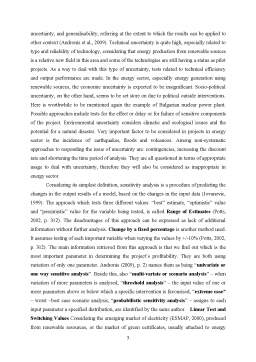Extras din referat
This assignment aims to present critically the approaches on valuation of environmental impacts and sensitivity and risk analysis in projects in Energy sector. Thus, the first part of this assignment presents the importance of Energy sector among political priorities and some particularities of the projects from Energy sector. The body of this paper deals with approaches of valuation of environmental impacts, presenting the different techniques used in assessing the value of the environment and then, in the second part there are presented the characteristics of sensitivity and risk analysis in projects from Energy sector.
Energy sector is generally regarded as having four main components: resource extraction, resources transportation, power generation, transmission and distribution of the energy. Therefore, when one speaks about projects in Energy sector, it can be in one of these domains. Energy sector is one of the top priorities of a country, as it has also a very heavy weight in relation to security of that country. As a supportive example, it can be reminded the recent issue between Russia and Ukraine regarding oil delivery. The decisions taken at that moment by the European officials (restarting the nuclear central from Bulgaria) proved the very important value given the Energy sector by the governing authorities.
The mantras climate change, global warming are to be seen overall, whatever discussion is in place at formal or informal level. When considering environmental impacts in projects in Energy sector, the possible impacts related to each type of resource used need to be considered. Regarding non-renewable resources, impacts are associated with air, water, and land. In case of oil and gas a particular attention is accorded to highly risks emerging during their transportation (UN, 1994, pp. 33-48).
Considering the actuality of the subject and the high unlikelihood that new power plants based on conventional resources will be constructed, this assignment will pay particular attention to economic analysis of environmental impacts of projects using either nuclear energy or renewable resources and markets from European Union particularly.
Nuclear Energy concerns power plants having as basic fuel the uranium. Environmental impacts can occur during the extraction, transportation and processing of uranium, but the most important ones are the radioactive materials that appear at the end of electric power generation process, and therefore the radioactive pollution. Radiation of humans during the normal operation needs to be considered and, of course, low probability but very high impact of nuclear accidents. Apart from radioactive pollution, nuclear energy sources produce thermal pollution, air and land pollution as well as solid wastes. (UN, 1994, pp. 49-54). Regarding the renewable sources of energy and their environmental impact, we can have: biomass energy, with impacts especially on air pollution resulted from biomass burning and also disposal of solid waste, geothermal – especially on land and water, solar – in terms of producing the necessary equipments (Ardente et al. 2005, p. 129) and sightseeing (Cassedy, 2000), wind power – land used for placing the power plants and pollution during production of the necessary equipment, ocean energy – altering the natural flow of the sea, and therefore altering the wildlife, waste energy – air pollution and disposal of solid waste, hydrogen fuel from renewable sources (Cassedy, 2000). Of course, the above presented forms of pollution are relevant in context of analysing their impact on human health and natural environment (UN, 1994).
The idea of “sustainable development - meeting the needs of the present generation without compromising the needs of the future generations” is worthwhile to be reminded in this context (Dixon et al., 1995, p.3). Especially if we consider the recent results of the Copenhagen Summit, it can be argued that valuing the environmental impacts is anything but agreed upon. Looking at the issue from economic analysis’s perspective, the literature presents a wide range of tools and methods for evaluating the environmental impacts of different projects. The importance of valuing the environment is underlined by following arguments (Winpenny, 1991, p. 6): reminds that environment is not a ‘free’ resource; it helps to redress the balance between quantifiable and non-quantifiable effects in cost-benefit analysis; narrows the field remaining for ‘pure’ judgement if many effects are valued; it provides a secure basis for policies to be induced. “Environmental externalities are seen to transcend national boundaries” (Potts, 2002, p. 163), and this is a very important aspect when it comes to projects from Energy sector.
Regarding the actual process of assessing effects on environment, two stages are identified: Environmental Screening and Environment Impact Assessment. Considering that environmental impact of projects in Energy Sector is expected to be significant (Cassedy, 2000), this assignment will consider in the following part the valuation techniques normally used in calculating the environmental impact. They are to be found under different classifications in literature. Kirkpatrick (2000) considers they are split between methods using market prices, using information on individuals’ preferences, benefit transfer while the majority of authors consider they are to be classified in Objective Valuation and Subjective Valuation. (Dixon et al., 1995), (Potts, 2002). Another important aspect that needs to be clarified in this context is the meaning of word ‘value’. It has been argued, that when the Economic Value of the Environment is considered, it actually consists of sum of three components: actual use value, option value and existence value. Glasson (1999, p. 20) distinguish between possible impacts: physical and socio-economic; direct and indirect; short-run and long-run; local and strategic; adverse and beneficial; reversible and irreversible; quantitative and qualitative; distribution by group or area; actual and perceived; relative to other developments. They are all tight related to energy sector projects.
Preview document
Conținut arhivă zip
- Project Appraisal and Economic Analysis.doc














